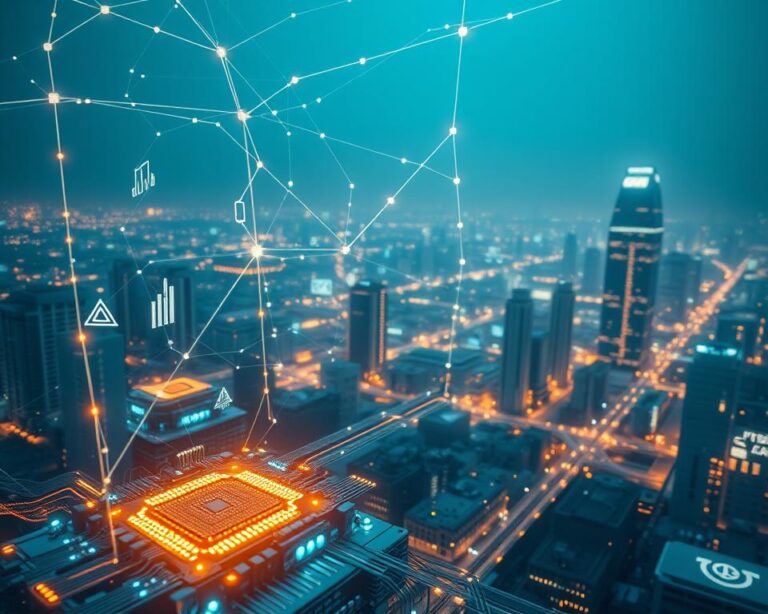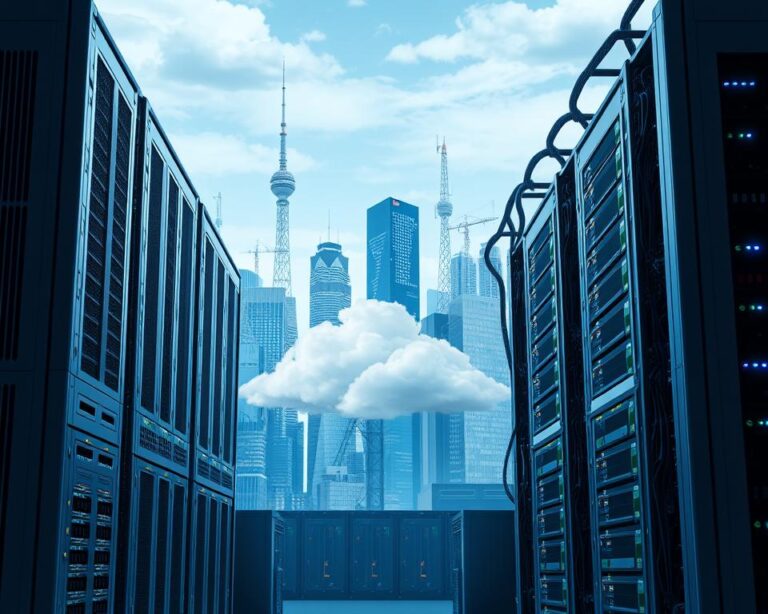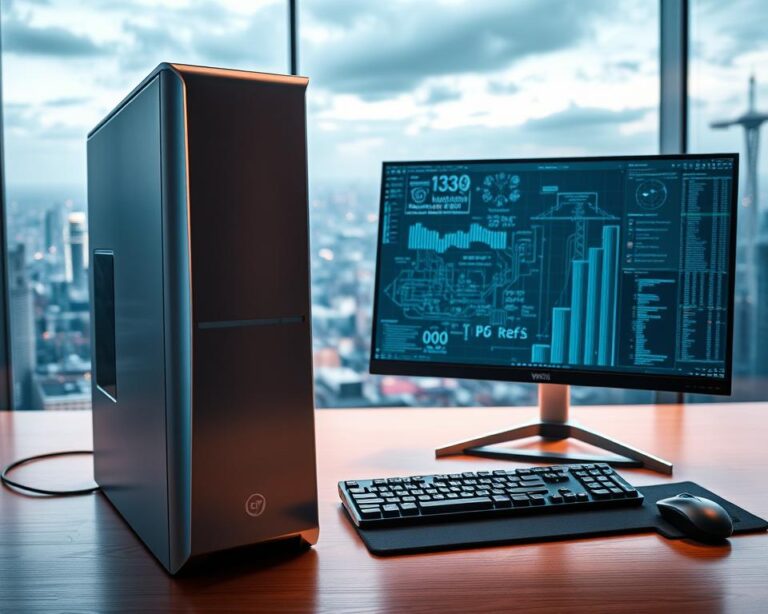
The Pros and Cons of Our Reliance on Technology
Did you know that over 90% of Americans own a smartphone, signifying a profound shift in how we communicate and interact with the world? This staggering statistic illustrates the impact of technology dependence on our daily lives. While our reliance on technology offers numerous advantages, including enhanced productivity and instant connectivity, it also raises important questions about the downsides, such as technology addiction and its effects on mental health. In this exploration of the pros and cons of technology reliance, we will delve deeper into how these tools have become an essential part of our lives, changing the way we work, learn, and connect with one another.

Key Takeaways
- Over 90% of Americans own smartphones, reflecting the prevalence of technology.
- Technology reliance offers increased productivity and efficiency.
- Digital tools aid in improving communication and collaboration.
- Concerns arise regarding technology addiction and its mental health impacts.
- Understanding both the benefits and drawbacks is essential for balanced technology use.
Understanding Technology Dependency
Technology dependency has become a defining aspect of life in today’s world. As technological advancements surge forward, individuals and societies have adjusted, often resulting in an over reliance on technology for everyday tasks. This evolution highlights how our interactions with various devices and platforms have shifted significantly.
Smartphones and social media platforms play a critical role in fostering this technological dependence in modern society. The convenience of communication and access to information encourages constant engagement, creating habits that many find challenging to break. Automation in various sectors further cements this dependency, streamlining processes but also raising questions about job security and individual skills.
The impact of technology dependency stretches beyond personal convenience. It influences collective functionality, reshaping human behavior and societal expectations. People often find themselves navigating daily life with the careful balance of leveraging technology while maintaining a sense of autonomy. Striking this balance remains an ongoing challenge in a world increasingly driven by technological solutions.

The Role of Technology in Modern Society
Technology has become an integral part of our lives, influencing nearly every aspect of daily routines. The role of technology is evident in how we communicate, work, and manage household tasks. From smartphones that keep us connected to smart home devices that enhance convenience, the impact of technology on daily life shapes our habits and choices.
In the contemporary landscape, technology’s impact on daily life is profound. It streamlines activities, allowing people to accomplish tasks more efficiently. Services like online banking, food delivery apps, and telehealth offer unparalleled convenience, transforming how we approach everyday responsibilities.
How Technology Shapes Our Daily Lives
The integration of technology into daily life guarantees enhanced productivity. Many individuals rely on digital calendars and task management applications to organize their schedules effectively. Social networking platforms enable instant communication with friends and family, regardless of geographic distance. This constant access to information fosters a sense of connection and community, illustrating the importance of connectivity.
The Importance of Connectivity
Connectivity plays a critical role in both personal and professional realms. The ability to communicate effortlessly through platforms such as Zoom, Slack, and WhatsApp has revolutionized teamwork and collaboration, enabling companies to operate more efficiently. In personal domains, technology helps maintain relationships, bridging gaps created by physical distance.
While increased connectivity brings numerous benefits, it also raises concerns about privacy and the balance between virtual and real-life interactions. Understanding the role of technology in shaping these dynamics is essential for navigating the complexities of modern living.

Benefits of Technological Advancements
Technological advancements have transformed various aspects of daily life and work environments. Embracing the benefits of technology can lead to remarkable improvements in both personal and professional settings. From enhancing productivity to improving communication methods, technology is a powerful tool that shapes how we connect and collaborate.
Increased Productivity and Efficiency
One of the primary benefits of technology lies in its ability to enhance productivity and efficiency. Tools such as project management software, cloud storage, and automated systems help streamline operations for businesses. Employees can complete tasks more swiftly, allowing for greater focus on strategic initiatives. The use of smart devices also contributes to increased efficiency, giving users access to essential tools on the go.
Enhanced Communication and Collaboration
The evolution in communication methods presents significant advantages for teamwork. Modern platforms like video conferencing, instant messaging, and collaborative document editing enable seamless interactions among team members, regardless of their physical location. Enhanced communication fosters a sense of community and inclusivity, making remote work more effective than ever.

| Technology Tool | Benefit | Effect on Productivity |
|---|---|---|
| Project Management Software | Task organization | High |
| Cloud Storage Solutions | Accessibility | Medium |
| Video Conferencing | Real-time collaboration | High |
| Instant Messaging Apps | Quick communication | Medium |
Leveraging these technological advancements enhances communication and boosts productivity, making it easier for individuals and teams to achieve their goals effectively. As technology continues to evolve, its potential to create an efficient, collaborative, and productive environment cannot be overstated.
Drawbacks of Technological Dependence
The increasing reliance on technology presents several significant drawbacks that deserve attention. One of the most pressing issues is its impact on mental health. With the constant availability of digital devices, individuals often find themselves experiencing heightened levels of anxiety and depression. Excessive screen time can disrupt sleep patterns and create a dependency on immediate gratification, which negatively affects emotional well-being.
Impact on Mental Health
The impact on mental health extends far beyond temporary feelings of stress. Studies indicate a direct correlation between high screen time and increased risks of chronic mental health issues. The constant comparison to curated online personas can lead to feelings of inadequacy and low self-esteem. Screen addiction further complicates these issues by fostering a cycle of avoidance, where individuals retreat into their devices instead of confronting real-world challenges.
Social Isolation and Disconnection
Social isolation has become a prevalent phenomenon as technology substitutes face-to-face interactions with virtual ones. While social media can connect users, it often fosters a false sense of connection. Many fail to recognize the genuine human interaction that is lost in favor of digital communication. The resulting disconnection from family and friends can lead to loneliness and exacerbate mental health struggles, demonstrating the profound drawbacks of technological dependence.

Are We Too Dependent on Technology Essay
The question of whether we are too dependent on technology is increasingly relevant in today’s fast-paced world. This technology dependency analysis reveals different facets of our relationship with digital tools that have become woven into the fabric of daily life. Observing our reliance on smartphones, social media, and the internet, one may ask: are we losing sight of what it means to interact without screens?
Many argue that reliance on technology enhances our productivity and communication. Instant access to information creates possibilities, fostering a culture of efficiency. Yet, this surge in technological integration invites a counterargument about our mental and social well-being. As we dive deeper into this “are we too dependent on technology essay,” we see how such dependency reshapes our identities and interpersonal relationships.
To stimulate reflection, consider examining daily habits influenced by technology. How often do individuals reach for their devices during conversations or activities? As we analyze these patterns, it becomes evident that striking a balance is essential. Acknowledging the pros and cons of technology dependence sparks meaningful discussions that can shape a healthier coexistence with the tools we embrace.
Technology Addiction: A Growing Concern
As our reliance on technology increases, the phenomenon of technology addiction becomes more prevalent. Understanding this issue involves identifying technology addiction and recognizing its impact on everyday life. Professionals highlight that excessive usage can lead to significant disruptions in various aspects of an individual’s routine.
Identifying Technology Addiction
Identifying technology addiction requires an examination of behavioral patterns and lifestyle changes. Observations can range from neglecting responsibilities to prioritizing screen time over meaningful interactions. Experts suggest that those experiencing technology addiction often display compulsive behaviors, such as incessantly checking notifications or feeling anxious without their devices. These signs are crucial for recognizing when technology use crosses the line into dependency.
Signs and Symptoms of Over Reliance on Technology
The symptoms of over reliance on technology manifest in multiple ways. Commonly reported indicators include:
- Compulsive browsing: Constantly needing to check social media or emails.
- Withdrawal symptoms: Irritability or anxiety when not using technology.
- Neglected personal relationships: Spending less time with family and friends.
- Decreased productivity: Struggling to focus on tasks without the distraction of devices.
- Physical symptoms: Eye strain or headaches from prolonged screen exposure.
Recognizing these symptoms offers a pathway toward addressing technology addiction effectively. Minimizing excessive use can promote healthier lifestyles and foster meaningful connections.
Excessive Use of Technology
Excessive use of technology has become a prevalent concern in today’s digital age. The rise in screen time has transformed how individuals, particularly younger generations, engage with the world. Understanding the screen time impact on daily life is crucial as it correlates with various health issues, both mental and physical.
How Screen Time Affects Our Lives
Prolonged screen exposure affects various aspects of life, often leading to shifts in daily routines and interactions. Data reveals that individuals can spend upwards of 10 hours a day on screens. This extensive usage disrupts personal connections and diminishes face-to-face interactions, highlighting a growing trend of social isolation.
Negative Effects on Physical Health
The negative health effects stemming from excessive use of technology are significant. Extended periods of screen time can result in:
- Eye strain and discomfort
- Poor posture, leading to musculoskeletal disorders
- Neglected physical activity, contributing to weight gain and related conditions
Statistics show that children and adolescents are particularly vulnerable, often averaging over seven hours of screen time each day, which can hinder their physical development. Balancing technology use is vital for maintaining overall well-being.
Impact of Technology Dependence on Youth
The reliance on technology significantly shapes the experiences and challenges faced by today’s youth. With the prevalence of smartphones and social media, young generations encounter unique hurdles that were virtually unheard of just a few decades ago. The impact of technology on youth extends beyond mere convenience, affecting their mental health and social interactions.
Challenges Faced by Young Generations
Today’s youth grapple with numerous challenges stemming from their heavy reliance on technology. Cyberbullying has emerged as a serious issue, with many young individuals experiencing harassment online. Digital addiction compounds these challenges, as the constant need for online engagement can impede their daily lives and academic performance. These issues emphasize the importance of addressing the challenges for young generations, especially in creating environments where they can thrive both online and offline.
Shifting Social Behaviors and Norms
The pervasive influence of technology contributes to changing social norms among youth. Traditional communication methods have shifted, as many prefer texting or messaging over face-to-face interactions. This shift alters the way friendships are formed and maintained, leading to varying social dynamics. While technology enables connections across distances, it also raises questions about the quality of these relationships and the skills required for effective interpersonal communication. Understanding these changing social behaviors is crucial for fostering healthy relationships in a technology-driven world.
Reducing Reliance on Technology
Finding a balance in technology use can significantly enhance overall well-being. Many individuals seek ways to manage their connection to devices and digital platforms. By implementing effective technology management strategies, it becomes possible to cultivate healthier habits and maintain focus on meaningful activities outside of screens.
Strategies to Manage Technology Use
To begin reducing reliance on technology, consider these actionable strategies:
- Set daily time limits for specific applications or devices.
- Schedule technology-free periods, especially during meals and before bedtime.
- Use apps that promote moderation in screen time by tracking usage and sending reminders.
- Engage in hobbies and activities that do not involve screens, such as reading, gardening, or exercising.
Encouraging Mindfulness and Balance
Integrating mindfulness practices into daily routines can help foster a balanced approach to technology. Techniques might include:
- Meditation and deep breathing exercises to increase awareness of technology consumption.
- Journaling to reflect on experiences with technology and its impact on mental health.
- Physical activities like yoga or tai chi, which emphasize presence in the moment.
- Engaging with nature as a way to disconnect and recharge mentally.
Technological Dependency in the Workplace
In today’s fast-paced environment, technology dependency in the workplace has become a defining characteristic of modern employment. Companies increasingly leverage tools to streamline tasks and enhance collaboration. While this shift promotes workplace efficiency and technology integration, several challenges arise alongside these benefits.
The advent of remote work has demonstrated the importance of technology in facilitating communication across teams. Platforms like Zoom and Microsoft Teams allow seamless interactions, regardless of location. These tools significantly boost productivity, enabling employees to connect, share ideas, and collaborate on projects from anywhere.
Automation has also transformed traditional workflows. By utilizing software to manage repetitive tasks, organizations can allocate their workforce to more strategic initiatives. This reliance on technology often results in increased efficiency and can lead to significant cost savings for businesses.
Despite these advantages, the heavy reliance on technology comes with potential drawbacks. Workers may experience burnout as they struggle to maintain work-life balance when technology blurs the boundaries between home and office. Furthermore, an over-dependence on technological solutions for problem-solving might hinder critical thinking and creativity, crucial skills for innovation.
To maximize the benefits of technology dependency in the workplace while mitigating its downsides, organizations must prioritize employee well-being. Establishing guidelines for technology use, encouraging breaks, and fostering a culture of open communication can help create a healthier work environment. Striking this balance is vital for ensuring that workplace efficiency and technology do not lead to adverse effects on employee satisfaction.
The Relationship Between Technology and Education
The integration of technology in education has transformed how students learn and educators teach. Digital tools offer numerous opportunities to enhance learning experiences. Instructional technology can foster engagement and increase accessibility, presenting both substantial advantages and notable challenges in educational settings.
Benefits of Digital Learning Tools
Digital learning benefits stem from the variety of resources available for both teachers and students. Interactive platforms such as online quizzes, educational apps, and virtual classrooms allow for personalized learning experiences. Students can progress at their own pace, accessing information that suits their individual learning styles. Furthermore, technology provides teachers with innovative methods to assess student performance and adapt their teaching strategies accordingly.
Challenges of Technology in Education Settings
Despite the advantages, several educational technology challenges persist. Disparities in access to technology among students can create gaps in learning opportunities. Some learners may struggle to engage with materials due to inadequate technological resources. Additionally, distractions from digital devices can lead to reduced focus on traditional learning methods, potentially hindering educational outcomes.
| Aspect | Benefits | Challenges |
|---|---|---|
| Accessibility | Wider reach of educational materials | Digital divide among students |
| Engagement | Interactive learning experiences | Potential for distractions |
| Personalization | Tailored learning paths | Implementation concerns for diverse learning needs |
Societal Implications of Technological Over Reliance
The increasing dependence on technology presents significant societal implications, particularly concerning employment and ethical practices. As automation and artificial intelligence reshape job markets, the landscape of work faces fundamental changes. Many industries find themselves at a crossroads where technology’s impact on employment shows both promise and concern, especially in terms of job displacement.
Impact on Employment and Job Markets
Technology’s impact on employment is profound, driving efficiency but also leading to potential job loss in various sectors. Frequently, roles that were once performed by humans are now conducted by machines, creating a shift that demands new skill sets from the workforce. Many employees face challenges in adapting, contributing to rising unemployment rates in certain areas, particularly among less skilled workers.
| Industry | Jobs Affected by Automation | New Job Opportunities Created |
|---|---|---|
| Manufacturing | 30% of workers | 10% in robotics and programming |
| Retail | 20% of cashiers | 5% in e-commerce support |
| Transportation | 25% of drivers | 8% in tech maintenance |
Ethical Concerns in Technology Use
As technology evolves, ethical concerns in technology arise around issues such as privacy and surveillance. Companies developing these technologies must take responsibility for how they are used, raising questions about data security and individual rights. The responsibility to create frameworks that dictate ethical usage falls on market leaders, ensuring that advancements do not infringe upon personal freedoms.
The Future of Technology and Society
The landscape of the future of technology is rapidly evolving, driven by a wave of emerging technologies. Innovations like artificial intelligence (AI), blockchain, and the Internet of Things (IoT) are reshaping our daily lives and influencing various sectors. Understanding these technologies and their potential impacts is crucial for individuals and organizations alike.
Emerging Technologies and Their Potential
Emerging technologies hold the promise of creating unprecedented opportunities. For instance, AI can revolutionize healthcare with predictive analytics and personalized treatments. Blockchain offers transparency and security in transactions, fundamentally altering financial systems. The IoT ecosystem enhances smart home solutions and urban infrastructure, improving efficiency and sustainability.
Preparing for a Tech-Driven Future
Adapting to this tech-driven future demands proactive strategies. Lifelong learning will become essential for workers to stay relevant as job roles evolve with technological advancements. Flexibility in both personal and professional settings will enable individuals and businesses to thrive amidst these changes. Preparations for tech advancements require a conscious approach, ensuring that while we embrace innovation, we also maintain a balanced relationship with technology.
Conclusion
As we draw our exploration of technology reliance to a close, it becomes clear that our dependence on technology is both a blessing and a challenge. This technology reliance summary has highlighted the transformative role that gadgets and software play in enhancing productivity, connectivity, and education, while also illuminating the potential pitfalls related to mental health and social interactions. Recognizing these dual facets is crucial for a balanced approach to technology use.
The insights gathered throughout this discussion encourage us to engage in thoughtful reflection about our personal and societal reliance on technology. Concluding thoughts on technology dependence suggest that by acknowledging both its benefits and drawbacks, individuals can cultivate a healthier relationship with technology. Strive for mindfulness and intentionality in how you integrate technology into your daily life, fostering connections without sacrificing well-being.
Ultimately, navigating these complexities can lead to a more responsible and sustainable future with technology. As we embrace the advances of the digital age, let’s prioritize balance, ensuring that technology enhances rather than diminishes the quality of our lives and interactions.



